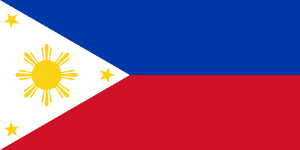
| Colors | HEX Code | RGB | CMYK |
|---|---|---|---|
| Blue | #0038A8 | 0, 56, 168 | 100, 67, 0, 34 |
| Red | #CE1126 | 206, 17, 38 | 0, 92, 82, 19 |
| White | #FFFFFF | 255, 255, 255 | 0, 0, 0, 0 |
| Yellow | #FCD116 | 252, 209, 22 | 0, 17, 91, 1 |
The flag of the Philippines has two horizontal stripes. The upper stripe is blue while the lower stripe is crimson red. A white, equilateral triangle is located at the hoist. A golden sun with eight primary rays is featured on the white triangle and three small golden stars are located at the corners of the triangle.
Meaning of the flag of the Philippines
The white triangle symbolizes liberty. The three stars represent the three major areas in the Philippines. The Sun with eight rays represents the eight provinces of the country. The blue color represents the willingness to sacrifice oneself for freedom, while the red color represents courage.
History of the Flag of the Philippines
The Philippines was under Spanish rule. In 1898 the Spanish rule was overthrown by the Philippine’s revolutionary army. The flag was designed to be hoisted after independence from Spain. The Americans took control of the country and the flag was banned until 1920, when it became legal again. In 1936, the Philippines was getting ready for independence and the flag was prepared to be officially adopted, however, the Japanese took control of the country and prevented the adoption of the flag. The Philippines finally became independent in 1946, and the flag was officially adopted as the flag of the new republic. The shades of blue were changed over time until the light royal blue was chosen in 1997 to represent the original Philippines flag.